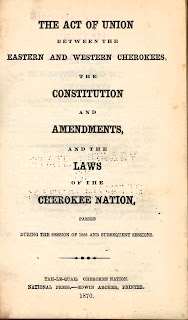The earliest origins of the State Library’s collections date back over 200 years to 1811 when a formal exchange program of law books with other U.S. States, Territories, and Native American Nations was established by the Massachusetts General Court. These legal collections expanded to a point where the State Library was formally established to house them in 1826. Over the past two centuries, the collections eventually grew to number almost 24,000 volumes and form a vast and vital part of the library’s 19th and 20th century holdings, making it one of the largest collection of state publications in existence.
 While some might call these “dusty old law books” in the
era of Westlaw and Lexis legal research, the volumes collectively tell the
story of our nation’s legal foundations as a democracy, and the growth of the
individual states to create the present United States of America. The State Library’s legal collections include
such varied items as the Laws of California written in their original Spanish, the
laws of Native Indian tribes and nations (i.e. Cherokee, Creek, Chickasaw,
Choctaw, Osage), some even in the original native language, and the laws of
various territories that eventually became the familiar U.S. States we recognize
today (i.e. Dakota, Illinois, Utah, Idaho, Washington, Hawaii).
While some might call these “dusty old law books” in the
era of Westlaw and Lexis legal research, the volumes collectively tell the
story of our nation’s legal foundations as a democracy, and the growth of the
individual states to create the present United States of America. The State Library’s legal collections include
such varied items as the Laws of California written in their original Spanish, the
laws of Native Indian tribes and nations (i.e. Cherokee, Creek, Chickasaw,
Choctaw, Osage), some even in the original native language, and the laws of
various territories that eventually became the familiar U.S. States we recognize
today (i.e. Dakota, Illinois, Utah, Idaho, Washington, Hawaii).  One of the most curious volumes in the collection has to
be the Laws of the Jefferson Territory,
the one and only law volume printed for the Jefferson Territory that existed
from 1859 to 1861 and encompassed a land area that would eventually become the
states of Kansas and Colorado but was never legally recognized by the United
States government. The dissolution of
the Jefferson Territory coincided with the fallout from the 1860 election of
President Abraham Lincoln that precipitated the subsequent secession of the
original seven states to form the Confederate States of America. In order to augment the number of free
states, the U.S. Congress quickly moved to admit the state of Kansas to the
Union on January 29, 1861. This action left
the remainder of the Jefferson Territory unorganized until February 21, 1861, when
it was made part of newly formed Colorado Territory, leaving its legal legacy
behind for posterity in one 303 page volume.
One of the most curious volumes in the collection has to
be the Laws of the Jefferson Territory,
the one and only law volume printed for the Jefferson Territory that existed
from 1859 to 1861 and encompassed a land area that would eventually become the
states of Kansas and Colorado but was never legally recognized by the United
States government. The dissolution of
the Jefferson Territory coincided with the fallout from the 1860 election of
President Abraham Lincoln that precipitated the subsequent secession of the
original seven states to form the Confederate States of America. In order to augment the number of free
states, the U.S. Congress quickly moved to admit the state of Kansas to the
Union on January 29, 1861. This action left
the remainder of the Jefferson Territory unorganized until February 21, 1861, when
it was made part of newly formed Colorado Territory, leaving its legal legacy
behind for posterity in one 303 page volume.Judy Carlstrom
Technical Services

